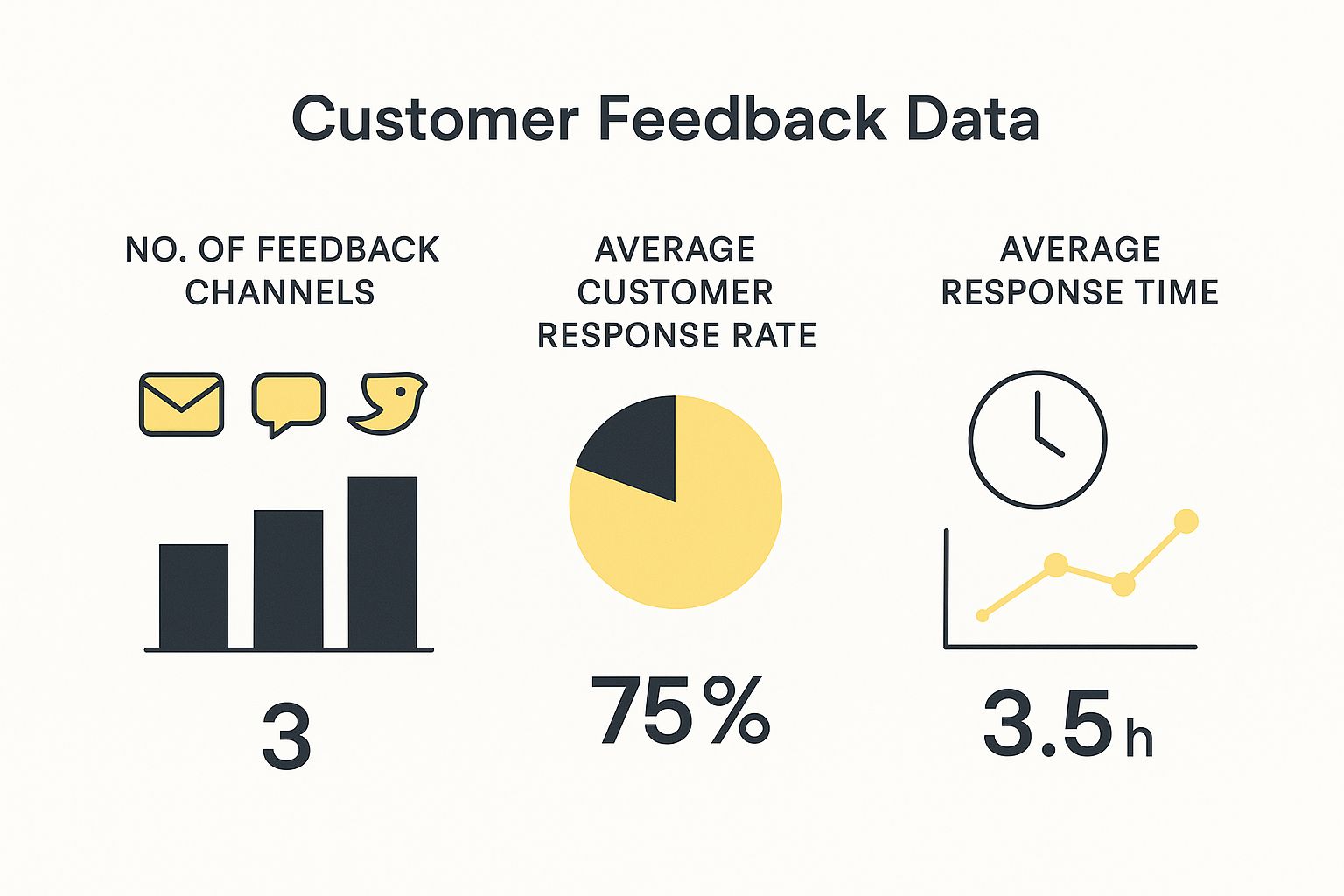Improving customer engagement isn't about one-off campaigns or just having good service. It’s about creating meaningful, proactive interactions that build real, lasting relationships—not just transactional ones. The goal is to make every customer feel seen, heard, and valued.
This means personalizing their experience, offering seamless support no matter where they are, and using technology to understand their needs before they even have to ask.
Building Your Foundation for Customer Engagement
Think of true customer engagement as a continuous process. It goes way beyond simple service transactions to foster genuine loyalty and turn customers into advocates. In today's market, people have endless choices. The quality of their interaction with your brand is what really sets you apart.
The foundation for this connection rests on a few core pillars that work together. A huge part of that is knowing how to create engaging content that actually resonates. After all, meaningful content is the fuel for every single interaction, from a social media post to your weekly newsletter.
Understand Who You Are Engaging
Before you can even think about improving engagement, you have to know who your customers are. I mean really know them. Generic, one-size-fits-all communication just doesn’t cut it anymore. You need a deep understanding of their pain points, what motivates them, and how they prefer to communicate.
This is where detailed customer profiles—or buyer personas—become absolutely essential.
The most successful engagement strategies are built on a bedrock of empathy. When you genuinely understand your customer's world, you can create experiences that resonate on a personal level and build unbreakable trust.
Putting these profiles together means gathering and analyzing data from every touchpoint you have: purchase history, website behavior, support tickets, you name it. This first step informs every single action you take from here on out. For a detailed walkthrough, check out our guide on how to create buyer personas in our article and get this foundation right.
The Core Pillars of Modern Engagement
Building a strong engagement strategy is a multi-faceted game. It's not about mastering one channel; it’s about creating a unified experience across all of them. To really nail this, there are a few non-negotiable elements you need to focus on.
To give you a clearer picture, I've broken down these fundamentals into a simple table. Think of these as the building blocks for every successful engagement initiative.
Core Pillars of Modern Customer Engagement
A summary of the fundamental strategies required to build and sustain high levels of customer engagement.
| Pillar | Key Objective | Primary Tactic |
|---|---|---|
| Genuine Personalization | Make customers feel understood and valued as individuals. | Use customer data to tailor communications, product recommendations, and offers. |
| Seamless Omnichannel | Provide a consistent and connected experience everywhere. | Ensure customers can move between your website, app, and social media without friction. |
| Proactive Interaction | Anticipate needs and solve problems before they happen. | Use data to identify potential issues and offer help before the customer has to ask. |
| Empathetic Support | Build trust and loyalty through understanding. | Train support teams to listen, understand context, and communicate with genuine care. |
Focusing on these pillars creates a framework that doesn't just attract customers—it turns them into loyal advocates for your brand. This guide will give you a detailed roadmap to put these strategies into action.
Using AI to Create Hyper-Personalized Experiences
Let's be honest, "Artificial Intelligence" gets thrown around a lot. But it's way more than just a buzzword; it's a seriously practical tool for scaling your customer engagement in ways that used to be pure science fiction. We're going to move past the theory and look at how real businesses are using AI today to forge deep, personal connections with their customers.
This isn't about replacing your team with robots. It's about letting smart tech handle the repetitive, data-heavy lifting. That frees up your people to focus on the nuanced, high-value conversations that actually build loyalty and turn customers into fans.
Moving Beyond "Hello, [First Name]"
Slapping a customer's first name in an email subject line was cool ten years ago. Today, it’s table stakes. AI-powered hyper-personalization goes so much deeper by using machine learning to analyze a customer's past behavior, what they've bought, and what they're doing right now to predict what they'll want next.
Picture an e-commerce store with an AI recommendation engine. Instead of just showing "people who bought this also bought...", it looks at a specific user's recent browsing, the products they've hovered over, and even their color preferences. Then it serves up products they are genuinely likely to fall in love with. That’s how you make every single interaction feel like it was designed just for them.
This chart from a Twilio Segment report really drives home how quickly businesses are jumping on this.

The data is crystal clear: nearly everyone is already using or planning to use AI in their customer engagement. It’s not a "nice-to-have" anymore; it's becoming essential.
How to Actually Use AI for Engagement
So, what does this look like on the ground? AI tools can be plugged into all sorts of customer touchpoints to make the experience feel more intuitive and responsive. Even small businesses can get in on the action. If you're curious, we have a whole guide on AI solutions for small businesses that breaks down some accessible starting points.
Here are a few powerful ways AI is already making a difference:
- Smarter Chatbots: Modern AI chatbots are a world away from the clunky bots of the past. They provide 24/7 support, handle surprisingly complex questions, and can pass a conversation to a human agent with the full context. No more making customers repeat themselves.
- Predictive Analytics: AI can sift through your customer data to spot the subtle signs that someone might be about to leave. This gives your team a heads-up to proactively reach out with a helpful offer or some extra support to keep their business.
- Sentiment Analysis: These tools are incredible. They can scan customer reviews, support tickets, and social media mentions to get a read on the emotional tone. This gives you a real-time pulse on how people are feeling, helping you catch problems early or identify happy customers to recruit as brand advocates.
With AI, businesses are no longer just reacting to what customers need—they're starting to anticipate it. This pivot from reactive to proactive is what creates those seamless, personal experiences that people remember.
This whole trend is picking up speed because AI is pretty much the only way to deliver these hyper-relevant interactions at scale. In fact, one report shows that 98% of organizations have already embedded AI into their customer engagement platforms or are in the process of doing so. People just expect real-time, context-aware experiences now, and AI is how you deliver. You can dig into more of these insights about 2025 customer engagement trends on segment.com.
Getting Started Without Overhauling Everything
Bringing AI into your strategy doesn't have to be some massive, intimidating project. The smart way to do it is to start small and build on your wins.
Here’s a simple way to approach it:
- Find One Big Pain Point: Where is your engagement weakest? Is it slow support response times? Are your product recommendations falling flat? Pick one thing.
- Start with One Tool: Choose a single AI tool that directly tackles that problem. It could be a simple chatbot for your website or a sentiment analysis tool for your Twitter mentions.
- Measure and Adjust: Keep a close eye on the results. Did the chatbot cut down your support ticket backlog? Did your social media sentiment scores go up? Use that data to tweak your approach and figure out where to go next.
By taking it one step at a time, you can start weaving AI into your workflow without overwhelming your team or your budget. The goal is simply to enhance—not replace—the human connections that are the real heart of your business.
Designing a Seamless Omnichannel Strategy
Your customers don’t see channels; they just see your brand.
Whether they’re scrolling through Instagram, opening your latest email, browsing your mobile app, or walking into a physical store, they expect the experience to feel connected. That’s the real secret to an omnichannel strategy—creating one unified journey, not a bunch of disconnected interactions.
This whole approach is about breaking down the internal silos that create those frustrating, disjointed experiences we've all had. Think about it from the customer’s point of view. Nothing is more jarring than adding items to a cart on a laptop, only to find the cart totally empty when they open the mobile app later. It just feels like the brand doesn’t have its act together.
Improving customer engagement here means making the flow between every touchpoint smooth and logical. The goal is to make it so easy to interact with you that they don't even have to think about it.

Mapping the Customer Journey
To build a truly seamless experience, you first need to get a clear picture of the paths your customers are already taking. Customer journey mapping is just the process of visualizing every single interaction a person has with your brand, from the moment they first hear about you to becoming a loyal fan.
This isn’t just some theoretical exercise. It’s a practical tool for spotting friction points. Where are customers getting stuck? Where do they drop off? Pinpointing these moments of frustration is the first step toward actually fixing them.
Start by identifying all your touchpoints:
- Digital: Website, mobile app, social media profiles, live chat, email newsletters.
- Physical: In-store visits, events, customer service phone calls.
- Indirect: Online reviews, word-of-mouth recommendations, press mentions.
Once you have your list, trace the common paths people take. A customer might see a product on Instagram, click through to your site to learn more, and then visit a physical store to buy it. Each of those handoffs should feel effortless.
The Power of a Unified Experience
A strong omnichannel strategy does more than just make things convenient; it reinforces your brand’s story and builds trust. When every channel offers the same level of service, customers feel understood and valued.
For instance, picture a customer who contacts support via live chat about a product issue. If they later call the support line, they shouldn't have to repeat their entire story from scratch. In a true omnichannel system, the phone agent would already have the chat transcript and be ready to pick up right where the conversation left off.
This level of cohesion means integrating your technology and your teams. Your CRM, e-commerce platform, and marketing automation tools need to talk to each other to create a single view of each customer. This unified data is the backbone of any effective personalization effort.
Real-time personalization is critical for improving customer engagement. However, Gartner research reveals that over 70% of customer experience leaders struggle to design strategies that lead to measurable business improvements, highlighting a clear need for better approaches. The key is the continuous orchestration of meaningful interactions across every channel. You can find more details about these findings on how to improve customer engagement at Sprinklr.com.
Practical Examples of Omnichannel Success
Let's look at how this plays out in the real world. Many top brands have this down to a science, making their customer interactions feel incredibly smooth.
| Brand Example | Omnichannel Tactic | Customer Benefit |
|---|---|---|
| Starbucks | Order and pay ahead on the app, then pick up in-store. | Convenience. The app saves payment details and past orders, making the process fast and eliminating wait times at the counter. |
| Nike | App features that connect online and in-store experiences. | Personalization. Customers can scan barcodes in-store for more info, reserve items for pickup, and receive tailored recommendations. |
| Disney | The My Disney Experience app and MagicBand technology. | Seamlessness. The app and band act as a park ticket, room key, and payment method, creating a frictionless, magical experience. |
These examples show that a great omnichannel strategy is all about anticipating customer needs and using tech to make their lives easier. One powerful tool for this is a Progressive Web App (PWA), which blends the best of websites and mobile apps. You can explore the many benefits of a progressive web app in our guide to see how it can help create a consistent experience across all devices.
Ultimately, designing your omnichannel strategy is about putting the customer at the absolute center of everything you do. By removing friction and ensuring consistency, you create an environment where engagement can naturally grow, leading to better loyalty and sustained growth.
Earning and Keeping Customer Trust Through Transparency
In a world overflowing with options, trust isn't just a nice-to-have—it's the actual currency of customer engagement. When people trust your brand, they stick around, spend more, and even become your biggest advocates. But that trust is delicate. You have to earn it, consistently, through transparent actions.
It all starts with a simple idea: be honest, even when it’s a pain. That means no-fluff communication, straightforward marketing, and owning up to it when things go sideways. Proactively telling a customer about a shipping delay or admitting a product has a flaw builds way more credibility than trying to sweep it under the rug.

Harnessing the Power of Social Proof
One of the smartest ways to build trust is to let your happy customers do the talking for you. This is the core of social proof—the psychological trigger that makes people feel more comfortable with a brand when they see others have had a good experience.
Let's face it, when a potential customer sees genuine reviews, testimonials, and user-generated content (UGC), it feels infinitely more authentic than any marketing slogan you could dream up.
Here’s how you can put social proof to work right away:
- Encourage Authentic Reviews: Don't be shy. Actively ask for reviews after a purchase or service interaction. Make it dead simple for customers to leave feedback on your website and third-party platforms.
- Showcase User-Generated Content: Create a branded hashtag and give customers a reason to share photos or videos of them using your product. Feature the best content on your social media and website (just make sure you get permission first).
- Display Testimonials Prominently: Don't bury your best testimonials on some forgotten corner of your site. Put short, punchy quotes right on your homepage, product pages, and even in your marketing emails.
This isn't just a hunch; the data backs it up. Customer trust in brands has been on a downward slide for years. In fact, consumer trust in retailers has plummeted by more than 50% since 2014. In response, brands are realizing that transparent communication is key, and online reviews have become massively influential—a staggering 88% of consumers now trust them as much as personal recommendations. You can dig into more of these customer engagement stats and see how they're shaping consumer behavior on vwo.com.
Prioritizing Data Privacy and Ethical Handling
In our data-driven world, how you handle customer information is a massive piece of the trust puzzle. A data breach or even the perception of misuse can wreck your reputation overnight. Being transparent about data isn't optional anymore; it’s a fundamental part of improving customer engagement.
People are savvier than ever about how their data is used, and they absolutely expect you to be a responsible steward of their personal information.
Trust is built in drops and lost in buckets. Every time you handle a customer's data with respect, you're adding a drop to the bucket. But one misstep can empty it completely.
To build trust through data ethics, you have to be clear, honest, and put customers in the driver's seat.
Building Trust Through Ethical Data Practices
| Action | Why It Builds Trust | Example |
|---|---|---|
| Clear Privacy Policies | It shows you have nothing to hide and respect their right to know. | Instead of a dense legal document, provide a simple, easy-to-read summary of how you collect and use data. |
| Easy Opt-Outs | It gives customers a sense of control over their experience. | Make unsubscribe buttons obvious in emails and provide clear settings to manage communication preferences. |
| Use Data for Good | Demonstrate that you use data to genuinely improve their experience. | Use purchase history to offer relevant product recommendations, not to bombard them with unrelated ads. |
At the end of the day, earning and keeping customer trust is an ongoing commitment, not a one-and-done project. It's woven into every single interaction, from your marketing copy to your privacy policy. By making transparency, social proof, and ethical data handling your priorities, you build a rock-solid foundation of trust that fosters deep, lasting customer engagement.
How to Measure Your Customer Engagement Efforts
You’ve probably heard the old saying, “You can’t improve what you don’t measure.” It’s a bit of a cliché, but when it comes to customer engagement, it’s the absolute truth. Pouring time and money into new strategies feels productive, but without tracking the right numbers, you’re just guessing what actually works.
To get a real handle on your engagement, you have to cut through the noise of vanity metrics. Likes and page views are nice, but they don't pay the bills. The goal is to focus on the key performance indicators (KPIs) that tell you whether you're building real, lasting relationships with your customers. This is how you prove the ROI of your hard work and make smart decisions instead of flying blind.
This chart highlights a few core metrics that businesses track, including the number of feedback channels they offer and how quickly they respond to customers.

As you can see, there's often a link between having more feedback channels and responding faster. It’s a good reminder that being accessible and quick to reply is a huge part of a solid engagement strategy.
Focus on Metrics That Matter
It's way too easy to get lost in a sea of data. Clicks and social media followers can make you feel good, but they don't always translate to a healthy business. The best metrics are the ones that give you a direct pulse on the health of your customer relationships and can even help predict long-term success.
Let's break down three heavy hitters that provide clear, actionable insights. These aren't just numbers for a dashboard; they’re direct signals of how well you're connecting with the people who matter most.
Customer Lifetime Value (CLV)
First up is Customer Lifetime Value (CLV). This is the total amount of money you can realistically expect to earn from a single customer over the entire course of their relationship with you. CLV is a powerhouse metric because it forces you to think beyond a single sale and focus on long-term value.
When your CLV is on the rise, it’s one of the clearest signs your engagement strategies are hitting the mark. Engaged customers don't just buy once; they come back for more. They’re also more likely to try new products and spend more over time. By keeping an eye on CLV, you can directly tie your engagement efforts to real financial results.
Net Promoter Score (NPS)
Next is the Net Promoter Score (NPS), which has become the gold standard for measuring customer loyalty. It’s beautifully simple, all based on one powerful question: "On a scale of 0-10, how likely are you to recommend our business to a friend or colleague?"
Based on their answers, customers fall into one of three camps:
- Promoters (score 9-10): Your biggest fans. These are the loyal, enthusiastic customers who not only keep buying but also tell everyone they know about you.
- Passives (score 7-8): They’re satisfied, but not wowed. They got what they paid for, but they could easily be tempted by a competitor's offer.
- Detractors (score 0-6): These are unhappy customers. At best, they won't buy from you again; at worst, they'll actively share their bad experience, damaging your brand's reputation.
To get your score, you just subtract the percentage of Detractors from the percentage of Promoters. A climbing NPS is a direct sign that your efforts are turning satisfied customers into true brand advocates.
Churn Rate
Finally, we have the Churn Rate. This is the percentage of customers who stop doing business with you over a given period. You can think of it as the ultimate anti-engagement metric. If your churn rate is high, something in your customer experience is broken.
Tracking churn is absolutely critical. We all know it costs way more to acquire a new customer than to keep an existing one. By watching this number closely, you can spot problems early, dig into why people are leaving, and make changes to improve retention. A dropping churn rate is a clear win, showing that your engagement strategy is building stickier, more valuable relationships.
Key Metrics for Measuring Customer Engagement
To get a clear picture, it helps to see these metrics side-by-side. Each one tells a different part of the engagement story.
| Metric (KPI) | What It Measures | Why It's Important for Engagement |
|---|---|---|
| Customer Lifetime Value (CLV) | The total revenue a customer will generate over their entire relationship with your business. | Directly links engagement to long-term profitability. Rising CLV means customers are staying longer and spending more. |
| Net Promoter Score (NPS) | Customer loyalty and their willingness to advocate for your brand. | A high score indicates you're creating enthusiastic "Promoters" who will drive word-of-mouth growth. |
| Churn Rate | The percentage of customers who stop using your product or service within a specific timeframe. | A direct indicator of customer dissatisfaction. Lowering churn proves your engagement efforts are improving retention. |
At the end of the day, these KPIs are more than just data. They provide a feedback loop that helps you continuously refine your strategy and ensure your engagement efforts lead to real, sustainable growth for your business.
Measuring these key metrics isn't just about crunching numbers for a report. It's about understanding the human experience behind the data. Every data point tells a story about a customer's journey, their satisfaction, and their loyalty.
To really nail this, it helps to learn from industries that live and die by customer satisfaction. For example, the principles behind learning how to improve guest satisfaction for 5-star stays apply almost anywhere. Creating an exceptional experience is a universal goal, whether you're running a hotel or a SaaS company.
Common Customer Engagement Questions
Diving into the world of customer engagement can feel a bit like learning a new language. You know the goal, but the path isn't always clear. It's totally normal to have questions pop up as you start putting these strategies into practice.
Let's cut through the noise and tackle some of the most common questions I hear. Think of this as your quick-start guide to turning theory into results that actually matter.
What Is the Best First Step for a Small Business?
If you're running a small business, the idea of a huge, multi-channel engagement strategy can feel pretty overwhelming. My advice? Don't even try to do everything at once. The key is to start small but smart.
Focus on the channels you already own and master them.
- Personalize your emails. And I mean really personalize them, not just with a
[First Name]tag. Segment your list based on what people have bought and send them recommendations or tips that are actually useful. - Be human on social media. Don't just post and ghost. Make it a rule to respond to every single comment, mention, and DM. A simple acknowledgment goes a long way in making someone feel heard.
- Actually ask for feedback. After a purchase or a service call, send a simple survey. More importantly, when you get that feedback, do something with it—and let your customers know you did.
You don't need a massive budget to show you care. These first steps build a habit of listening and responding, which is the absolute core of great customer engagement.
How Is Engagement Different from Customer Service?
This is a fantastic question because the two are so closely linked, but they're fundamentally different. The easiest way to think about it is proactive vs. reactive.
Customer service is reactive; it’s about solving a problem after it has already happened. Customer engagement is proactive; it’s about building a strong relationship to prevent problems and foster long-term loyalty.
Let's say a customer can't log into their account. A great customer service team will jump in, quickly help them reset their password, and get them back on track. Problem solved. That's reactive.
Now, a great customer engagement strategy would have seen that a recent site update might cause login issues for some people. The company would proactively send an email with clear instructions, a helpful FAQ, or a short video tutorial. This move anticipates the customer's need, prevents frustration, and shows the brand is genuinely looking out for them.
Great service is a huge piece of the puzzle, but it's just one part of a much bigger strategy that aims to create positive interactions at every single touchpoint.
Is It Possible to Over-Engage with Customers?
Oh, absolutely. There is a very fine line between being helpful and just being annoying. Bombarding people with constant emails, notifications, and social media posts is a surefire way to get them to hit the unsubscribe button.
The goal is to be a welcome presence, not an overwhelming one.
Finding that balance comes down to listening—to your data and to your customers. Keep a close eye on your metrics. If you see a spike in email unsubscribes right after launching a daily newsletter, that’s your sign to pull back. Watch your open rates and click-throughs to see what messages and what frequency actually resonate.
Most importantly, give your customers control. Let them easily manage their communication preferences. Do they want weekly emails or just a monthly roundup? Do they prefer SMS alerts for shipping but want to opt out of promotional texts? Giving them these choices shows you respect their time and their inbox, which is a powerful engagement tactic all on its own.
The aim is to be consistently valuable, not just consistently present.
Ready to build a digital presence that captivates your audience and drives real results? Up North Media specializes in custom web development, data-driven SEO, and AI consulting to help businesses like yours accelerate growth. Schedule your free consultation today!
